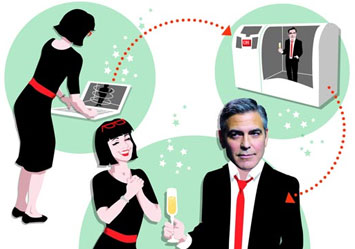News
3D world takes shape

Imagine a world where pretty much any solid object you can think of could be turned into reality. Thanks to 3D printing technology, that world already exists and the possibilities are bounded only by imagination.
3D printing is the term that describes a variety of techniques that can be used to build a solid object layer by layer, in the same way a document is printed out line by line.
The technology can work with a range of materials, from plastic and resin through to metal, glass and even ceramics, and can be used to create highly intricate and durable designs.
3D printers look a bit like microwave ovens and can be used to create a range of items from jewellery and figurines to crockery and home decor. They are also commonly used to create dental crowns.
Designer Val Butterworth uses 3D printing to translate her ideas for porcelain dinnerware and light shades into reality for her business, The Mod Collective. She uses 3D computer-aided design (CAD) software to create the concepts and then has the prototypes printed in 3D by Melbourne-based company Inition Thinglab. These printed prototypes are used to create the moulds from which she makes her commercial products.
"Using 3D printing, I can get all different patterns on the outside of them instead of them just being plain," Butterworth says.
A student in Ohio, US, Alec Cox, even used the technique to print his fiancee's and then his silver wedding ring last month.
While the process is quite expensive compared with traditional techniques for forming moulds, Butterworth says it enables her to actualise patterns and textures that she otherwise couldn't achieve by hand.
Cost is quickly ceasing to be an issue, with Thinglab's Joe Farr saying the cost of 3D printers has plummeted. His company specialises in 3D technology for modelling, scanning and printing, and is selling the MakerBot 3D printer for US$1750.
"Even very small companies that do design work can buy their very own printer so they can create their very own prototypes," Farr says.
"And we have some people who are looking at buying a MakerBot because they produce small batches of items and to get them manufactured is going to cost them a lot of money."
Numerous 3D printing bureaus have also sprung up around the world, including Shapeways and Sculpteo, which allow you to upload your own designs to be printed out. You can also select from a range of preloaded designs and have them printed on demand in a range of materials.
To create an object, you'll need some knowledge of 3D modelling tools, such as Google's free SketchUp tool, open-source tool Blender or more powerful commercial tools such as Rhino and AutoCAD.
Alternatively, you can scan an existing object using a 3D scanner or take your objects to a company such as Thinglab, that will scan them for you. Once you have the design rendered in software, you can have it printed out as often as you like, at whatever size you want (within the limits of the printer) and in a wide range of materials and finishes.
Ad Feedback
One of the concerns about 3D printing is that people will use it to scan or create items for which they do not own the copyright, such as movie-character figurines or designer home wares. But Shapeways and Sculpteo point out that such activity is in breach of their terms of service, and designs that breach copyright will be taken down as soon as they are discovered.
The technology is also starting to raise interest from the engineering industry, for the rapid creation of prototype parts and even short production runs of finished goods.
Jeff Condren's company, SOS Components, is now printing small numbers of specialised metal parts, such as those needed when a car is converted from left-hand to right-hand drive. He sees a big opportunity in direct digital manufacturing.
"We've made parts that have gone directly into motor vehicles, making the right-hand-side version of the left-hand-side part," Condren says.
He believes that eventually we will see machines that can make multi-material components that are as reliable as those made from traditional injection-moulding techniques.
"We are in the industrial revolution of the 21st century," he says.
Source :
http://www.stuff.co.nz/technology/6916199/3D-world-takes-shape/
- Cover Story
-
 SketchUp Can Help You Win Interior..
SketchUp Can Help You Win Interior.. -
 Best Laptops for SketchUp
Best Laptops for SketchUp -
 How to Resize Textures and Materials..
How to Resize Textures and Materials.. -
 Discovering SketchUp 2020
Discovering SketchUp 2020 -
 Line Rendering with SketchUp and VRay
Line Rendering with SketchUp and VRay -
 Pushing The Boundary with architectural
Pushing The Boundary with architectural -
 Trimble Visiting Professionals Program
Trimble Visiting Professionals Program -
 Diagonal Tile Planning in SketchUp
Diagonal Tile Planning in SketchUp -
 Highlights of some amazing 3D Printed
Highlights of some amazing 3D Printed -
 Review of a new SketchUp Guide
Review of a new SketchUp Guide
- Sketchup Resources
-
 SKP for iphone/ipad
SKP for iphone/ipad -
 SKP for terrain modeling
SKP for terrain modeling -
 Pool Water In Vray Sketchup
Pool Water In Vray Sketchup -
 Rendering Optimization In Vray Sketchup
Rendering Optimization In Vray Sketchup -
 Background Modification In sketchup
Background Modification In sketchup -
 Grass Making with sketchup fur plugin
Grass Making with sketchup fur plugin -
 Landscape designing in Sketchup
Landscape designing in Sketchup -
 Apply styles with sketchup
Apply styles with sketchup -
 Bedroom Making with sketchup
Bedroom Making with sketchup -
 Review of Rendering Software
Review of Rendering Software -
 Enhancing rendering for 3d modeling
Enhancing rendering for 3d modeling -
 The combination of sketchup
The combination of sketchup -
 Exterior Night Scene rendering with vray
Exterior Night Scene rendering with vray






